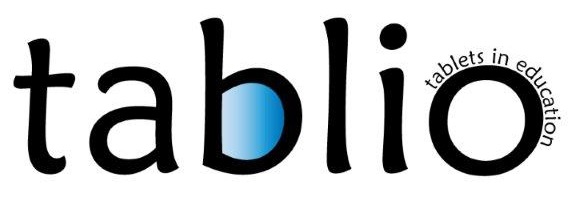1. Definition
2. Aims of differentiation
3. Characteristics
4. Stakeholders
5. Organisational differentiation
6. Educational differentiation - Learner Oriented
7. Educational differentiation - Teacher oriented - Content differentiation
8. Educational differentiation - Teacher oriented - Process differentiation
9. Educational differentiation - Teacher oriented - Product differentiation
1. Definition

“Differentiation” aims for the inclusion of all students, for a higher motivation to learn and to participate in life-long learning and for achieving learning outcomes more efficiently. On a more general level, the objectives of differentiation are self-realisation and self-actualisation on both the cognitive, emotional and social level and the striving for harmonious and pluralistic citizens for society and humanity. For these reasons, differentiation should be considered as a necessary aspect of all education.
Differentiation can be considered to be qualitative when it meets the following characteristics: pro-active, goal-oriented, structured, varied and transparent. Qualitative differentiation also requires cooperation from stakeholders on both the micro-level (classroom-level), meso-level (school-level) and macro-level (policy-level).
Differentiation can appear in two main types: organisational differentiation and educational differentiation.
Organisational differentiation (also: structural differentiation) can be operationalised in various ways: the grouping strategy of the classroom, individualized programs for special needs, extra-curricular acceleration programs and remedial programs.
Educational differentiation (also: classroom differentiation) happens within the context of the classroom. It can be more learner oriented when it focuses on differences in student’s readiness, interests and learning profile. It can also be more teacher oriented when it focuses on content-differentiation, process-differentiation and/or product-differentiation. There as a mutually influence of teacher oriented and learner oriented differentiation techniques.
Differentiation may appear to be very complex and unreachable goal, but this is a misconception: differentiation is above all a feasible and achievable educational approach.
2. Aims of differentiation
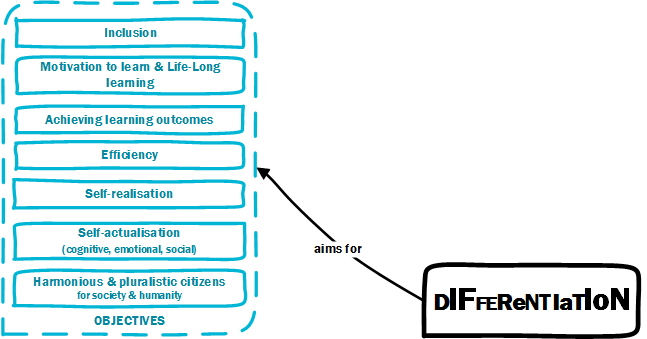
The aim from differentiation is to create a learning environment which encourages students to engage their abilities to the greatest extent possible, including taking risk and building knowledge and skills in what they perceive as a safe, flexible environment. Differentiated instruction is important for all students, not only those who have specific learning needs or disabilities.
Differentiation aims for:
- Inclusion: teachers adapting teaching methodologies to students’ needs favour the inclusion of each student into the learning and teaching process. According to Leicester (2008), school practices are inclusive when they cover a broad range of schooling experiences and succeed in helping children with diverse backgrounds and abilities to be effective learners.
- Motivation to learn: the purpose of differentiated instruction should be to bring each student to learning and to enhance ‘the learning match’ between the students and the curriculum. Thus, teachers should develop products that reflect students’ capability to facilitate learning for students of different readiness levels and with different interests and learning profiles; all features that can affect the construction procedure of new competences.
- Life-long learning: the positive outcomes of differentiation strategies will encourage learners to participate in learning activities during their entire professional career and private life.
- Achieving learning outcomes (effectiveness): differentiated and inclusive pedagogy is directly linked to effective learning as it aims at connecting to the individual’s learning profile and finding teaching styles through which they can learn more effectively and gain maximum benefit. According to Crawford (2008), the key to effective differentiation is to adjust the curricular components of content, teaching strategies and assessment continuously in response to adolescents’ interests, readiness levels and learning profiles, in order to encourage the development of a classroom of full inclusion. In a differentiated classroom students are active at their learning: they take responsibility for their learning process. This will lead to a higher ownership of learning and will increase the chances of achieving the learning outcomes. Learning outcomes could also become richer and more diverse as students get more openness (ag. open-ended problem tasks) in the learning process.
- Efficiency: in a differentiated educational context, chances are more likely that students spend time to learning tasks that match their zone of proximal development. Less time is wasted to learning tasks that are either too difficult, to easy or that aren’t adapted to their learning profile. Using ICT-devices (eg. the tablet) can also increase the efficiency as learning progress can be shared and monitored automatically.
- Self-realisation: by introducing differentiation, teachers could facilitate opportunities for talented students to produce a product that reflects their potential.
- Self-actualisation: differentiated instruction helps in maximizing students’ opportunities for personal learning and growth. Teachers should differentiate education in order to encourage the development of the whole person: a mean to teach students differently, to take them out of the classroom and into society.
- Harmonious and pluralistic citizens for society and humanity: differentiation aims at having a learning environment that provides confidence to students to enhance their capabilities and building knowledge and talent in a flexible, safe environment. It should encourage independence and ensuring student performance and overall wellbeing to grow as responsible and active citizens in their society.
3. Characteristics
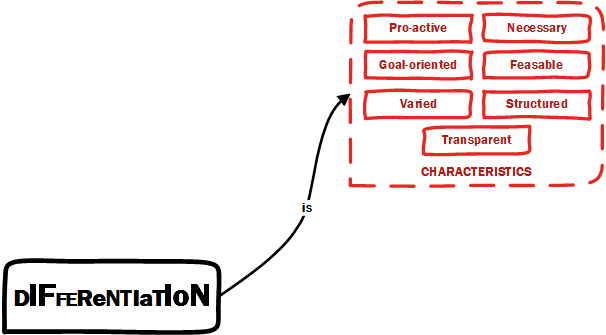
What are the key characteristics for effective and efficient differentiation?
- Pro-active: Teachers will have to learn how to develop a classroom routine and not to ignore variance in students’ readiness, interest and learning profile. Such routines may be defined as differentiating curriculum and instruction. It is a pedagogical, not organizational approach, in which teachers proactively modify curricula, teaching methods, resources, learning activities, and student products to address the diverse needs of individual students and small groups of students to maximize the learning opportunity for each student in a classroom. (Tomlinson, Brighton, Hertberg, Callahan, Moon, Birmijoin, Conover & Reynolds, 2013). The reactive approach would be that a teacher plans one lesson for the whole classroom and adapts his approach when a problem arises. This is not desirable.
- Goal-oriented: in a differentiated educational context the learning goals are central to the learning and teaching. A discussion can rise whether all students should acquire the same learning goals. For regular education, this would certainly be the case. Only in specific cases of inclusive education, it may be possible that some students aren’t required to achieve all goals.
- Varied: key to differentiation is the aspect of variety. This can be teacher-driven what would mean that the teacher varies in his educational offer of learning tasks and objects. Variation can also be student-driven when the educational context stimulates autonomy and ownership of the student. The student has the freedom to choose which learning tasks or learning objects he chooses to accomplish the learning outcomes.
- Transparent: transparency should be offered in terms of learning objectives and outcomes. A rubric is an interesting way to give transparency to the student. The students should have a clear image of the expectancies at the very beginning of the learning process. In more open ended learning processes, the student may have the opportunity to formulate the learning outcomes themselves. This should also be discussed transparently. Another aspect of transparency in differentiation is that teachers dare to express the differentiation process openly in the classroom. All students should be aware of the differentiation techniques and should take it for granted as well.
- Structured: the method of the differentiation should be clear to all persons involved.
- Feasable: Though teachers support the idea of inclusive classroom via differentiation, they tend to resist to adapting materials, planning lessons for individuals, changing evaluation procedures and instructional practices, make long-range plans or adapt scoring and grading criteria (Tomlinson, et al. 2003). Although there may be a learning process involved for the teacher, we believe differentiation to be feasible, especially when using tablets in the educational differentiation process.
- Necessary: for realizing truly inclusive classrooms with respect to everyone’s learning needs and talents.
4. Stakeholders
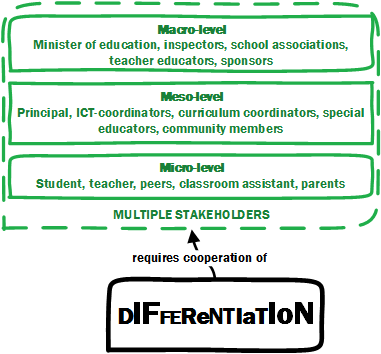
In order to make differentiation a structural, pro-active, systemically integrated aspect of education, stakeholders on three levels should invest energy in it and cooperate with each other.
- Macro-level: European, national and regional policy makers should emphasize the aspect of differentiation in their educational policy documents (eg. national curricula). School inspectors and teacher educators can be an important vehicle for transferring this policy into local schools and classrooms.
- Meso-level: school policies should incorporate and explicit the need for differentiation. Intra- and inter-school collaboration and exchange between teachers on differentiation should be promoted.
- Micro-level: not only the teacher and the student, but also other classroom assistants and most importantly the parents should be engaged in the process of differentiation. This starts with informing each stakeholders but can evolve to participation and negotiation.
5. Organisational differentiation
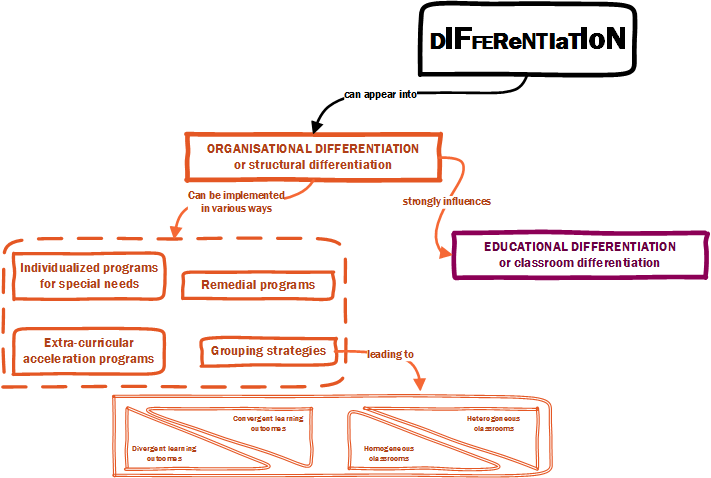
Organisational or structural differentiation covers the differentiation actions on a school level or a program level (curricular level). It can be implemented in four main ways.
-
Individualized programs for special needs:
Special education is the practice of educating students with special educational needs in a way that addresses their individual differences and needs. Ideally, this process involves the individually planned and systematically monitored arrangement of teaching procedures, adapted equipment and materials, and accessible settings. These interventions are designed to help individuals with special needs achieve a higher level of personal self-sufficiency and success in school and in their community that may not be available if the student were only given access to a typical classroom education.
Common special needs include learning disabilities, communication disorders, emotional and behavioural disorders, physical disabilities, and developmental disabilities. Students with these kinds of special needs are likely to benefit from additional educational services such as different approaches to teaching, the use of technology, a specifically adapted teaching area, or a resource room.
Teachers who provide special education services in schools must be certified to do so and will focus on his strengths as well as his challenges. The services and supports they receive may differ. It’s all about individualization. What is important is giving kids the resources they need to make progress in school. Usually special needs students are removed from their regular classroom and taught in another setting.
-
Remedial programs:
Remedial programs (also known as developmental education, basic skills education, compensatory education, preparatory education, and academic upgrading) are designed to close the gap between what a student knows and what he’s expected to know. It is usually used to build basic skills and designed for any students, with or without special needs. They often target reading or math weaknesses and can help them catch up their peers. In many cases, students are removed from their regular classroom and taught in another setting.
Not all programs are effective. An effective remedial program is taught by a professional teacher with special training. Programs need to be implemented in small groups. The idea is to get more individual attention than is possible in a large class.
-
Extra-curricular acceleration programs:
Extracurricular programs are educational activities not falling within the scope of the regular curriculum. They are voluntary and could be organized at school or not. These types of activities include sports, music, arts, academic clubs and many other after-school activities.
Extracurricular activities have many positive effects on students. They help them gain new skills, learn to socialize, gain leadership ability and learn more about their own interests. At the same time participation in after-school activities is linked with better academic performance and higher self-esteem of students.
Many extracurricular activities, such as the school newspaper, photography, and drama, can lead to careers. Extracurricular activities also help to form the student's profile for consideration in college or job admissions.
-
Grouping strategies:
School systems have developed different ways to manage the diversity of the student population. They select and group students into education levels, grade levels, different schools, programs, and different groups within schools on various ways.
Grouping strategies on organizational level include vertical stratification (by age), and horizontal stratification (between and within schools or programs).
- Vertical stratification of students is a result of development. As student populations grew in size and diversity, schooling was increasingly differentiated “vertically”. This vertical stratification resulted in the creation of different grades and education levels.
- Horizontal stratification on organizational level means adapting curricula to different groups of students, based on their ability. There are two main types of horizontal stratification:
- Between schools: separating students into different schools based on ability, often involving a division into academic/general and vocational schools; often referred as “tracking”.
- Within schools: when providing different curriculum standards to different groups of pupils based on their ability; different ability groups can be placed in different classroom or in the same classroom; ability groups are typically implemented to teach core subjects; remedial groups and special needs program are also a case of such differentiation; also referred as “streaming”.
The rationale behind using these differentiating mechanisms is to homogenize the student population so that its educational needs can be met more effectively. But there is some concern that horizontal stratification replicates existing social and economic inequities, as socio-economically disadvantaged students tend to be disproportionately grouped into low achieving groups.
Homogenous student groups are result of differentiation. Homogenous grouping began as a response to traditional classrooms, in which a single teacher is responsible for a number of pupils who are typically diverse in terms of their levels of educational attainment, language proficiency, cultural background, and other characteristics. However various studies have showed that this practice does not contribute to overall school success. Researches on readiness have showed that homogeneous grouping may have positive effects on students with good overall study results, but at the same time it has negative effects on students with lower overall study results. Various studies have demonstrated that homogeneous groups increase the differences in performance among pupils, and it does not improve their overall performance. In homogeneous classrooms, low achievers learn less because they spend less time on instructional activities, the material and content they are exposed to is less challenging, instruction is of lower quality and the pace of instruction slower. Finally, horizontal stratification on school level limits the opportunities for upward mobility between groups and reduces students’ satisfaction with their group placement. It is highly likely that children belonging to vulnerable groups will be assigned to low-achieving groups, and this contributes to students being segregated, categorized, stigmatized, and socially stratified. The same is true for children with disabilities, whose attainment levels may decline even further.
Heterogeneous groups or mixtures in educational settings are groups that include students with a wide variety of instructional levels. Heterogeneous groups stem from the education precept that a positive interdependence can arise from students with varied learning levels working together and helping each other to reach an instructional goal.
For students of lesser abilities, there is usually an advantage in being included in a heterogeneous group rather than homogenous group. They don't have the risk of being stigmatized as part of a less-able group. A heterogeneous group gives advanced students a chance to be a mentor to their peers. All members of the group may interact more to help each other understand the concepts being taught.
Which teaching strategies teachers choose to use seems to relate to the implicit or explicit learning goals they have for their classroom as a whole. From a ‘theoretical’ point of view teachers can strive for convergence or divergence.
- Teachers aiming at convergence are mainly focusing on reaching a minimum performance level with all of their students, which implies they might have to dedicate additional time and effort to the low achieving children in order for them to reach that minimum performance level, even when this goes at the expense of the high ability children, who by consequence receive less attention.
- Teachers aiming at divergence mainly focus on helping all children to reach their highest potential, equally dividing attention between students with lower and higher ability. In practice though, most teachers will combine convergent and divergent goals and will try to reach a minimum performance level with the low ability students, while also offering high ability children the opportunity to extend their knowledge without proceeding (too much) ahead of their peers in the classroom.
The potential convergent or divergent effects of varying differentiation strategies are not fully clear, as research shows mixed results, and therefore it is difficult for teachers to make explicit decisions on when to use which differentiation strategy, for what goal.
The effect of differentiation is considered to be divergent when the effect size is largest for high ability students and convergent when the effect size is largest for low ability students.
Divergent thinking is the process to create several unique solutions intending to solve a problem. The process of divergent thinking is spontaneous and free-flowing, unlike convergent thinking, which is systematic and logical. When using convergent thinking, we use logical steps in order to choose the single best solution. By using divergent thinking, instead of only choosing among appointed options, we search for new options. Convergent thinking stands firmly on logic and less on creativity, while divergent thinking is mostly based on creativity. We use divergent thinking mostly in open-ended problems that creativity is a fundamental part.
Convergent thinking is the opposite of divergent thinking. Convergent thinking is the process of finding a single best solution to a problem that we are trying to solve. Many tests that are used in schools, such as multiple-choice tests, spelling tests, math quizzes, and standardized tests, are measures of convergent thinking.
6. Educational differentiation - Learner Oriented
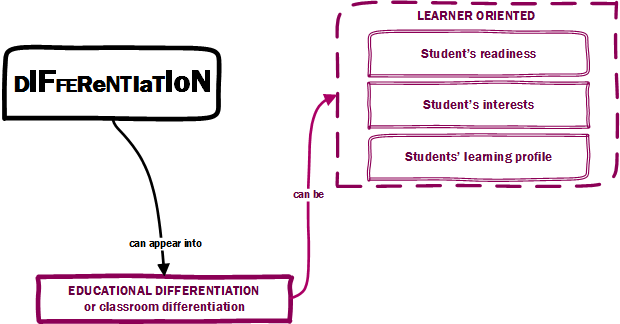
From a learner oriented point of view, there are three categories of student characteristics that can be taken into account.
- Student’s readiness: Student readiness or initial situation is the knowledge or skill level that individual learners have already mastered with respect to a topic or task that is planned for them to be engaged with (they are supposed / about to address?). Differentiation of curriculum and instruction as a response to student readiness: Individual learns in his or her zone of proximal development. Teacher has to be there for support and help students to become independent thinkers and problem solvers. Instruction must be in advanced, challenges at the proper level of difficulty.
- Student’s interests: Tasks that are interesting to students increase their motivation to deal with it, they are more productive, creative, persistent and autonomous. Rather than “How can I motivate students?” a teacher should think about “What motivates this particular student and how do I design work that is responsive to these motivations?”
- Student’s learning profile: The term learning profile refers to a student’s preferred mode of learning that can be affected by a number of factors, including intelligence preference, gender, and culture. Learners at primary, middle, and high school levels achieve better when instruction matches their preference.
Important note: learning styles are not an advised way to differentiate between students since they fail to challenge the students to use different ways of learning and don’t lead to higher learning outcomes (De Bruyckere, Kirschner & Hulshof, 2015).
7. Educational differentiation - Teacher oriented - Content differentiation
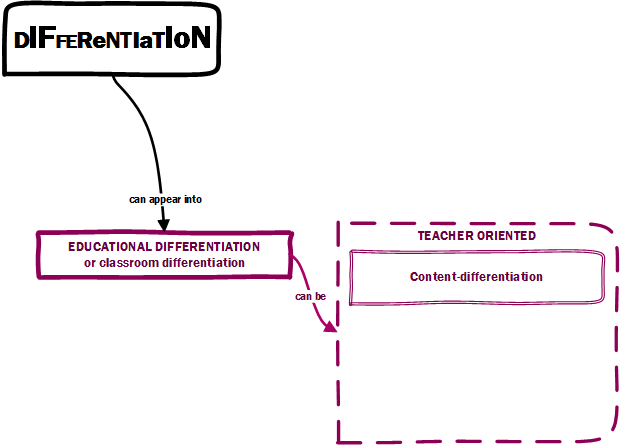
Content differentiation is concerned with:
- providing students with information through a variety of sensory inputs e.g. audio, visual etc.;
- providing students with a variety access points to information and considers how they access the information and what they need to learn;
- assessment that directly influences instruction.
Content differentiation can include:
- variation in texts;
- accelerated coverage of material;
- assorted supplementary materials;
- varied visual information;
- independent study;
- tiered assignments -based on pre-assessments.
8. Educational differentiation - Teacher oriented - Process differentiation
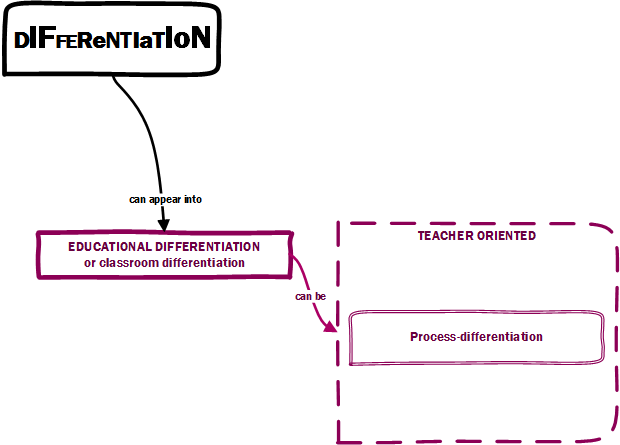
To differentiate by process, teachers use sense-making activities with students to enable comprehension of content. Differentiation by process involves giving students opportunities to explore key concepts. It gives them the chance to come to grips with the material they’ve been learning, to play with it, twist it, experiment with it, and test it.
Process differentiation can take place according to each of the student characteristics mentioned before (readiness, interest, learning profile)
One way to differentiate by process is by using flexible grouping of students. Flexible grouping is a range of grouping students together. This can be as a whole class, a small group, or with a partner. Flexible grouping creates temporary groups that can last an hour, a week, or even a month. It’s not permanent, but it is a temporary way for students to work together in a variety of ways and configurations depending upon activity and learning outcomes.
In differentiated instruction, teachers should ensure that their students have multiple options for taking in information and making sense of concepts.
Educators should take the time to:
- get to know their students and understand who they are as individuals;
- invite them to be active participants of their learning process;
- offer various methods through which modify curriculum components;
- increase the possibility for students’ success.
9. Educational differentiation - Teacher oriented - Product differentiation
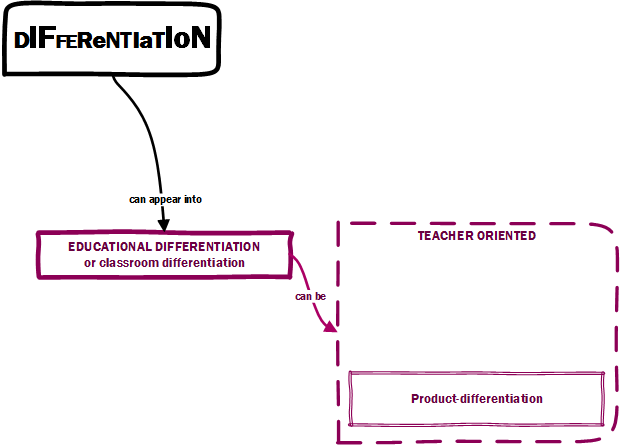
In order to evaluate your students’ development better and clearly, alternative assessment techniques should be used, in addition to traditional assessment techniques. An alternative assessment is a student-centered approach and it concentrates on the level of the utilization of learning and abilities to actual life, taking the individual characteristics of the students into consideration. As traditional assessment just considers the practices in the intellectual zone, the alternative approach watches the improvements in emotional and psychomotor practices. Portfolio, project, performance assignments, concept maps, structured grids, descriptive branched trees, word association, self-evaluation and peer evaluation are accepted as the tools of alternative assessment and evaluation. Alternative assessment is more functional in defining the students individual needs, changes and differences.
